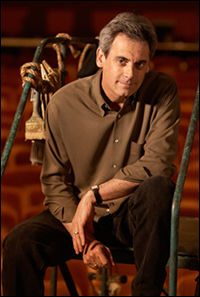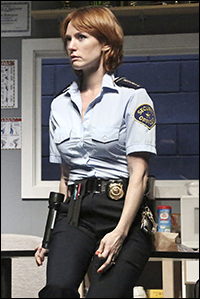
*
When the time comes for a new — or established — work by Neil LaBute to arrive on the West Coast, chances are the work will be at the Geffen Playhouse, where LaBute has become one of the theatre's most frequently produced playwrights. His Tony Award-nominated Reasons to Be Pretty will have its Los Angeles premiere opening Aug. 6 featuring Nick Gehlfuss, Shawn Hatosy, Amber Tamblyn and Alicia Witt, with Geffen artistic director Randall Arney at the helm.
The cast members are all first-timers to the Geffen stage, and Arney will be directing his first LaBute show, but the production still has a feeling of old home week. The Geffen-LaBute pipeline dates back to the 2007 West Coast premiere of Fat Pig directed by Jo Bonney. A LaBute play or adaptation has been part of the Westwood theatre's lineup nearly every year since: Some Girl(s) (2008), Wrecks (2010), The Break of Noon (2011) and LaBute's adaptation of Strindberg's Miss Julie (2013).
Plays and personalities both have to be a fit, says LaBute, whose friendship with Arney and with the company's late producing artistic director Gil Cates dates back even further.
"It's not just the play or whether it does well. I think it's a connection between people," says LaBute, speaking from New York where his latest play The Money Shot will have its world premiere in September. "I think Gil, Randy and I have all enjoyed each other's company and have a similar sense of what we loved about theatre. For a job that's so nomadic, such a gypsy job, it's nice to have places where you see some familiar faces." Particularly, LaBute adds, faces belonging to people who "get" your work and who can provide spaces like the 149-seat Audrey Skirball Kenis Theater, that can provide the kind of audience-performer intimacy that the work might demand. (For the record, Reasons will bow not in the Audrey, but on the 522-seat Gil Cates Theater.)
"Part of it is the world that Randy and casting director Phyllis Schuringa come from. They come out of Steppenwolf and there's a kindness, a sort of relaxed Midwestern sensibility about them that I really appreciate," the playwright continues. "Theatre can get a little high-strung; it can get a little precious sometimes. When we see each other, we smile. It's an easygoing kind of thing. We like our work and we're very serious about it, but I don't think we take it too seriously. We don't let the drama overtake the drama that's on stage, and that's very important to me. For someone who tends to spend days creating drama on the page, I run from drama in life."
 |
||
| Randall Arney |
"I just love the truth he tells," says Arney. "Neil is such a talent and his plays are so real as far as dialogue is concerned, and yet there's such a rhythm and musicality to it as well."
Reasons to Be Pretty, the culmination of LaBute's trilogy delving into the nature of beauty and appearance, charts the fallout stemming from an offhand remark made by Greg about his girlfriend Steph as he describes the face of another woman. The remark does not go over well, and the fallout spreads to engulf Steph's friend Carly and Carly's fiancée (Greg's best friend) Kent. The only play of LaBute's to reach Broadway, Reasons to Be Pretty received a Tony nomination for Best Play in 2009.
LaBute held on to the Los Angeles rights to Reasons to Be Pretty, which he hoped would play the Geffen. There had been some initial talk of the Geffen staging Reasons to Be Pretty and its sequel, Reasons to Be Happy, in repertory during the 2013-14 season, but when the summer opening on the Geffen mainstage came available, they plugged in Pretty.
"A story like this isn't operatic," says LaBute. "Some big things happen to some little people, but they are everyday things and you want them to be experienced in kind of an everyday way. There are working-class people in this play and Randy and I have talked about what it was like to work as young people and get our hands dirty. I think he understands the fabric of who these people are." Back in Los Angeles, Arney conducts a dinner break interview during tech week with three quarters of his reasons cast. They arrive in costume: Tambyln (Steph) in pajamas, Witt (Carly) in a crisp light blue security guard uniform and Hatosy (Greg) in factory fatigues. The two women have both seen earlier performances of reasons, with Tamblyn having caught the show's Off-Broadway and Broadway productions and being blown away on both occasions.
 |
||
| Amber Tamblyn in Reasons to Be Pretty. |
||
| Photo by Michael Lamont |
She got her wish. The Geffen version restores four lengthy monologues from the play's London production — one per character — that give insights into what Steph, Kent, Greg and Carly are experiencing. Following a discussion between Arney and Tamblyn, LaBute wrote a new monologue for Steph which will be unveiled for the first time in the Geffen production. Instead of talking about her pain over Greg's unfortunate remark and her perception of her features, Steph now talks about rummaging through old items and making a discovery.
Tamblyn had felt the original monologue was too explanatory for a play that is so much about subtext. LaBute agreed to write a new version, which he produced in approximately four hours.
"And it's perfect," says Tamblyn. "I sent him a picture that I had of myself when I was four, in a rocking chair. I'm smiling and laughing and I keep it in my dream journal. I told him 'This is it. This is what you wrote and you didn't even know I had it.'"
"If you think of a playwright of his caliber writing something so utterly feminine and feminist," Tamblyn continues, "I think this (monologue) should forever shut the ugly mouths of the people who think he's a misogynist." The production is Witt's second LaBute production following a turn as Evelyn in a production of The Shape of Things in London. Given the ways they tap into difficult emotions and situations that women experience, both roles have proven to be cathartic, says Witt.
"What Carly is going through in this play is something I have experienced and there is nothing more vulnerable for a woman," says Witt. "Her whole life, you get this sense she's been put on this pedestal. So in her mind, she doesn't have much to offer except her looks and she thinks that's enough because she has been told that it is. I'm really enjoying it because I get to process everything and get to experience it and then I get to leave it here at the Geffen."
 |
||
| Witt in Reasons to Be Pretty. |
||
| Photo by Michael Lamont |
"When I first read the play, I thought I had misdiagnosed Greg," says Hatosy. "In this group he's the intelligent one, he's the reader, but his relationship with Steph is completely dysfunctional. But as I started peeling it all back, I realized that here's a guy who, not only is he not a man, but he's dim. He has these clues. He has the roadmap to figure out where he needs to get with this relationship, but he just misses it every step of the way."
The culmination of Reasons to Be Pretty includes a fight scene. LaBute says that in the play's London production, his one quibble was that the fight was "a little Bridget Jones for my taste, not quite as exciting and breathtaking as I hoped the fight could be." At the Geffen, he's in good hands as two of Arney's recent productions were a revival of David Mamet's American Buffalo and Tracy Letts' Superior Donuts. Both productions employed the talents of violence designer Ned Mochel who enabled the Donuts cast to literally trash the stage.
"As was the case in Superior Donuts, we have a character who, for whatever reason, hasn't found enough passion to have something to fight for," says Arney. "And a moment in the play comes where the character finds something worth making a stand over."
"It's meant to be pretty messy," adds LaBute. "I'm expecting Randy to bring that kind of blue collar, no-nonsense knowhow to the fight and give the Westwood theatregoers a little bit of a thrill."









